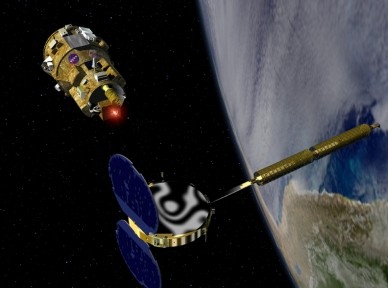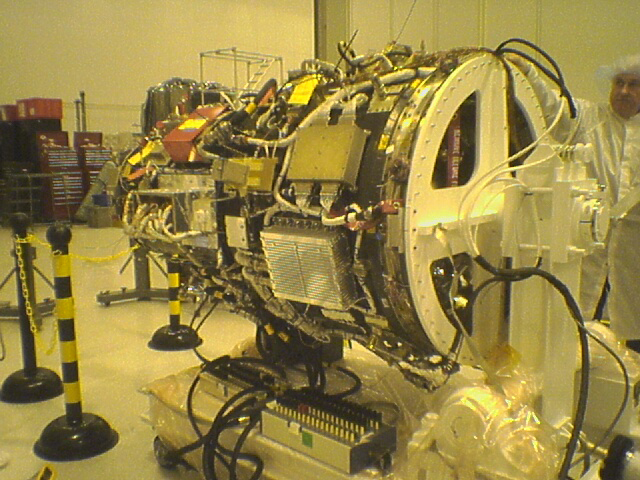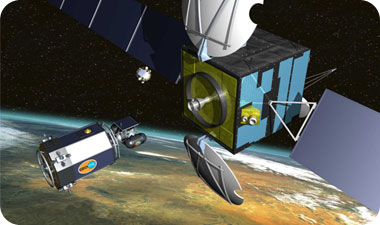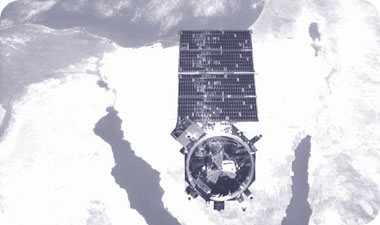What happens when a satellite orbiting the Earth needs refueling? Special satellites are used to refuel at an altitude of 36,000 km above the equator. All about the development of maintenance, refueling and upgrading satellites

Satellites orbiting the Earth need fuel for their maneuvering and stabilization systems. For the most part, it is a dimethyl hydrazine (UDMH) type fuel stored in a tank inside the satellite. Whether it is a photography satellite, a space telescope or a communication satellite - when the fuel runs out, the satellite becomes a useless tool that cannot function, even if all its other systems are in order, its solar cells provide electricity and the communication with it works.
If we remember that communication satellites, for example, cost many hundreds of millions of dollars, and are able to operate for many years (most of them more than a decade - for example, the first Israeli communication satellite, Amos 1, which was designed and built in the Israeli Aerospace Industries' space factory, has been operating successfully in space since 1996 , and will be replaced during this year by his younger and modern brother Amos 3), and that communication satellites earn a lot of money, it is a great shame to lose these satellites due to the loss of their fuel, when they could have been used for months and years more otherwise.
Based on economic and technological analysis, several enterprising companies in the space field began to develop an idea of refueling satellites in space, and in particular communication satellites, operating in a special orbit at an altitude of 36,000 km above the Earth's equator. This orbit is known as a geostationary orbit - a satellite located in this orbit orbits the Earth in a time equal to the time of the Earth's rotation around itself, and is thus fixed above a certain point on the Earth's surface. Launching satellites into this orbit is not an easy task, and a significant part of the fuel in them is used for positioning maneuvers in their orbit. Exceptions are satellites that are launched directly into a geostationary orbit, rather than a transit orbit, and it is worth noting that one of the first satellites in the world to be launched using this maneuver will be the Amos 3 satellite owned by the Israeli Space Communications Company.
Space maintenance
The accepted name for the concept of maintenance, refueling and upgrading of satellites is OOS - On Orbit Servicing. The most prominent (and most expensive) example is the Hubble Space Telescope's maintenance missions. This space telescope was launched into space by NASA in 1990, and has since received several visits by space shuttles, which brought with them new equipment (the solar cells, computer, gyroscopes, camera and various electronic assemblies were replaced over the years) and a team of skilled astronauts who performed a number of A lot of floating in space for the purpose of handling the telescope. The obvious disadvantage of this maintenance is its high cost - each upgrade and maintenance task cost hundreds of millions of dollars, and sometimes even more. The advantage - the ability to improvise, to invent and to overcome faults that the astronauts demonstrated, and which would have been avoidable if it was a robotic mission.
Preparation for service in space
Today, satellites are built without the ability to be maintained in space, except in exceptional cases (including the Hubble Space Telescope and unique satellites for technology demonstrations). This means, for example, that it is not possible to open panels, replace satellite assemblies or refuel them.
One of the ideas that various research bodies are currently examining is the standardization of the entire connection to satellites. Such standardization will enable the development of maintenance satellites that can handle a wide variety of satellites, from different countries and for different applications. A German company has developed a system that can connect to any communication satellite in geostationary orbit - by connecting to the exhaust nozzle of the engine installed in these satellites, which was used for the maneuvers required to bring them to their place in the geostationary satellite belt. For the purpose of the connection, an extremely sensitive laser rangefinder and contact sensors were developed, in addition to a mechanical locking mechanism that can be attached to the exhaust nozzles, which are conical in shape. Various experiments with this technology seem promising, and its great advantage is independence from the design (planning) of a specific satellite, so that one service satellite can connect to any target satellite.

Services to be provided to satellites in space
Service satellites will be able to reach the satellites in diverse orbits - from low orbits (LEO) at an altitude of hundreds of kilometers, to high orbits (36,000 km). It is understood that the cost of launching and operating - and as a result the cost of service to the customer - will vary depending on the altitude of the satellite and the nature of the service that will be ordered. In general, the types of space service for satellites can be divided into categories:
* Examination and observation - the service satellite will approach the target satellite, up to a distance of tens of centimeters, and examine it closely. The results of the examination (usually high-resolution images) will be forwarded to the customer, who will be able to verify the condition of the satellite and evaluate the additional services that will be ordered, such as replacing assemblies, releasing stuck parts (such as an antenna), etc. In this type of service, the satellite providing it does not have to connect to the target satellite, but rather perform proximity operations.
* Maneuvering - this type of service is more complex than examination and observation services, and it includes physically connecting to the target satellite and performing a change in its orbit. A change can mean raising a satellite from a low orbit to a high orbit (for example, in the case of a launch failure, and "stuck" of a satellite intended to reach a geostationary orbit in a low orbit, where it is worthless); Lowering a satellite that has ended its life into a low orbit that will eventually lead to its burning in the atmosphere, for the purpose of keeping space clean of satellite debris and fragments; Maneuvering within the geostationary belt and moving satellites to a new location and more.
* Maintenance - this type of service is the most complex, so its cost will also be high. As part of the satellite service, the treatment and maintenance satellite will come close to the target satellite, perform a scan and diagnosis, and then connect to it. Then the maintenance operations themselves will begin, which can include disassembling solar cells and replacing them with new ones, installing new satellite systems in place of systems that have failed or become obsolete, repairing assemblies that have malfunctions, and so on. It is understood that satellites that require maintenance in space will be planned in advance accordingly, and replaceable assemblies will be installed on special fasteners, without the need for soldering or screwing - so that the service satellite can easily remove them from the site and replace them with a new system that it will bring with it. It will be necessary to design an opening for the satellite to fill with fuel, which can be delivered from the refueling and service satellite (this system was actually developed in the Soviet Union back in the XNUMXs, for the Salyut space stations, to which fuel was delivered from unmanned and automatic supply spacecraft of the Progress type).
Micro-satellites - for maintenance and service tasks in space
The maintenance tasks in space are particularly suitable for small satellites, called microsatellites. These satellites excel in their small size and low weight (when launched they usually weigh tens of kg to about 150 kg), relatively short development time and simplicity. In recent years, microsatellites of the United States have already demonstrated their ability to carry out activities near other satellites, as part of experiments by the US Air Force (Xss-10 and Xss-11 satellites) and as part of NASA (DART mission - Demonstration for Autonomous Rendezvous Technology).
One of the difficulties in automatic proximity missions is the need to maneuver very carefully and delicately near the target satellite, without damaging it. NASA's DART mission failed, in fact, because during one of the approach maneuvers the maneuvering spacecraft hit the target satellite. The DART mission is unusual among NASA missions, as most of its technical aspects are classified and have not been released to the public. The American Air Force invests efforts in examining the technologies of proximity activity in space, among other things to examine satellites of other countries, and even develop the ability to act against them when necessary, and this by a variety of means: deliberate collision, hiding the field of view of photography satellites, creating an overload on the satellite or Short, the darkening of his solar cells, etc.

Geo Ring - entrepreneurship in orbital repairs and services for satellites
The Geo Ring company is a commercial company that unites several European companies and entities, which develops a concept of refueling communication satellites in a geostationary orbit. The company plans to develop several service satellites, including a tanker, a mini-satellite to transfer the fuel and a micro-satellite to observe and supervise the processes of approaching, docking and handling the target satellite. The company has already registered several patents related to the refueling and maneuvering system, and it already has signed memorandums of understanding with companies and operators of communication satellites - including the Arab communication satellite corporation Arabsat, headquartered in Saudi Arabia.
The company's website describes the various scenarios of service for geostationary communication satellites, and among other things it appears that the company plans to build a small satellite that will hold the communication satellite and be able to operate a rocket engine located in it, in order to place the communication satellite in a new place in the geostationary belt. A satellite of this type could also be used to raise a communication satellite that has ended its operation to a very high orbit, in order to make room for another satellite (nowadays, geostationary satellites perform this maneuver towards the end of their activity, but sometimes, due to a malfunction, the maneuver is not carried out and the satellite remains in its place, taking up valuable space of a replacement satellite, and over time, and drifts in its orbit, it may endanger neighboring satellites).
security implications
The ability to operate near satellites, on the one hand, and the possibility to perform various activities on them, on the other hand, could one day pose a risk to the satellites. Although, it is easy to understand that upgrading and maintenance activities in space will be the property of a few countries, but in the future this technology could be cheaper and be within the reach of countries that are not necessarily responsible and observing international law. The operators of the various satellites must prepare for the future possibility of manipulation and deliberate sabotage of satellites, among other things by installing a system to detect approaching satellites and perform evasive maneuvers from them, or even neutralize them.
This vision seems like science fiction or the distant future, but it could be realized within a decade or two.
The Defense Advanced Research Projects Agency (DARPA) of the United States, together with the Boeing Company, NASA and the US Air Force, carried out a very successful series of approach, connection and disconnection experiments of two dedicated satellites, ASTRO and NEXT SAT, as part of a research program known as Orbital Express. As part of the program, the automatic approach and docking capabilities were sampled, as well as complex operations performed using a remotely controlled robotic arm.

How much does it cost?
At this stage, there are no exact estimates of the cost of the service for handling the satellites. It is understood that complex tasks or tasks in a high track will cost more than simple exam tasks in a low track. However, in order for the use of service satellites to be economical, the developers of the service satellites (such as the Hermes system of the Geo Ring company) must reach a balance point between the cost of the mission and the price that will be charged from possible customers.
It can be assumed that a communication satellite that deviated from its orbit or did not reach it at all due to engine failure would be a very suitable candidate for re-orbiting, since even at a price of tens of millions of dollars the total loss in the event of a failure would be reduced. By the way, it is likely that insurance companies that insure satellites will be customers of this kind of service, since after rescuing a stray satellite and placing it in orbit, the company will be able to sell it to the operator (

3 תגובות
Fascinating on hard levels
Really really interesting.
Hope the space field will help us earthlings.
Stunning
I thought most of the "power" was drawn from solar energies.
Fascinating article. The field of space is developing at a fast pace, what was seen a decade ago as science fiction today is already a reality. As a result, some of the things described in the article may look and sound like science fiction, but in a few years this will be reality. Israel has the duty to develop these capabilities and get ahead of our enemies in this area.